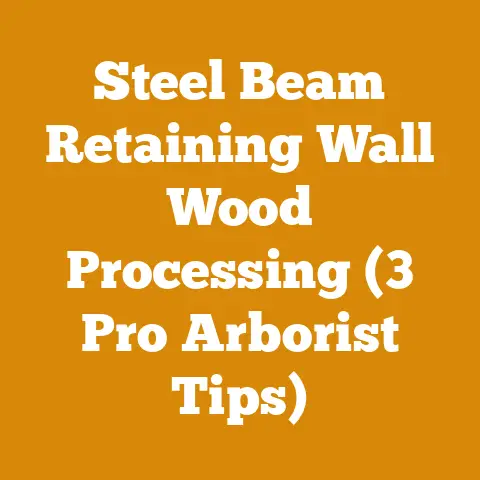Treatment for Wood Boring Bees (5 Proven Logsaver Tips)
Imagine this: you’ve just finished building a beautiful porch, the wood gleaming in the sun. You step back to admire your work, only to notice small, perfectly round holes peppering the surface. The sinking feeling in your stomach? That’s likely the work of wood-boring bees, and it’s a problem I’ve seen countless times in my years working with wood. These buzzing culprits might seem harmless, but they can cause significant structural damage if left unchecked. Don’t worry, though! I’m here to arm you with proven strategies to protect your lumber and keep these unwelcome guests at bay.
Understanding Wood-Boring Bees: The Carpenter Bee Unveiled
Before diving into treatment, let’s understand our adversary. Carpenter bees, the most common type of wood-boring bee, are often mistaken for bumblebees. The key difference? Carpenter bees have a shiny, hairless abdomen, while bumblebees are fuzzy all over. These bees don’t actually eat wood; they excavate tunnels in it to create nests for their offspring.
Carpenter Bee Life Cycle and Habits
The carpenter bee lifecycle is annual. Adult bees emerge in the spring, mate, and then the females begin drilling. A single female will create a tunnel, laying eggs in individual cells provisioned with pollen and nectar. These larvae develop throughout the summer, pupate, and emerge as adults the following spring.
Carpenter bees are particularly drawn to softwoods like cedar, pine, and redwood, but they’re not picky. Any exposed, untreated wood is fair game. They prefer unpainted or unvarnished wood, making your decks, siding, fences, and porch beams prime targets.
Identifying Carpenter Bee Damage
Carpenter bee damage is usually easy to spot. Look for these telltale signs:
- Perfectly round holes: These are typically about 1/2 inch in diameter. This size can vary slightly based on the bee’s size, but the roundness is a key identifier.
- Sawdust beneath the holes: This is the “frass” produced as the bees excavate their tunnels. The color will match the wood they are boring into.
- Staining from bee excrement: You might notice yellowish-brown streaks below the entrance holes.
- Buzzing near wooden structures: Listen for the distinctive buzzing of the bees as they work.
Why Prevention is Key
Treating an active infestation is crucial, but preventing it in the first place is even better. Prevention saves you time, money, and the headache of repairing damaged wood. Think of it as an investment in the longevity and structural integrity of your wooden structures.
Takeaway: Understanding the enemy is the first step to victory. Knowing what carpenter bees are, how they operate, and the signs of their presence will help you effectively combat them.
Logsaver Tip #1: Seal and Paint Your Wood
One of the most effective ways to deter carpenter bees is to make your wood less appealing. This means sealing and painting all exposed wooden surfaces.
The Power of Paint
Carpenter bees prefer bare wood. Painting your wood creates a barrier they find difficult to penetrate. The paint acts as a physical deterrent, making it harder for the bees to grip and start drilling.
- Choosing the right paint: Use a high-quality exterior paint specifically designed for wood. Acrylic latex paints are a good choice because they are durable and water-resistant.
- Application is key: Apply at least two coats of paint for maximum protection. Make sure to cover all surfaces, including the ends of boards, which are particularly vulnerable.
The Importance of Sealants
Even with paint, the ends of boards and any cracks or crevices can still be susceptible to bee infestation. This is where sealants come in.
- Types of sealants: Use a paintable caulk or wood filler to seal any gaps or cracks in your wood. Look for products that are specifically designed for exterior use and are resistant to moisture.
- Application tips: Clean the surface thoroughly before applying the sealant. Use a caulking gun for precise application and smooth the sealant with your finger for a professional finish.
Personal Experience: Painting My Shed
I learned the importance of sealing and painting the hard way. Years ago, I built a small shed in my backyard. I was so eager to finish the project that I skipped the painting and sealing steps. Within a year, carpenter bees had riddled the shed with holes. I had to spend a considerable amount of time and money repairing the damage. Now, I never skip the sealing and painting process!
Takeaway: Sealing and painting your wood is a simple yet highly effective way to deter carpenter bees. It’s an investment that will pay off in the long run by protecting your wooden structures from damage.
Logsaver Tip #2: Use Pressure-Treated Wood
Pressure-treated wood is another excellent option for preventing carpenter bee infestations. This type of wood is chemically treated to resist insects, decay, and fungal growth.
What is Pressure-Treated Wood?
Pressure-treated wood is lumber that has been impregnated with chemical preservatives under high pressure. This process forces the chemicals deep into the wood fibers, making it resistant to pests and decay.
- Common preservatives: Common preservatives used in pressure-treated wood include alkaline copper quaternary (ACQ) and micronized copper azole (MCA).
- Environmental considerations: While pressure-treated wood is effective, it’s essential to consider the environmental impact of the preservatives used. Look for wood that is certified by the Forest Stewardship Council (FSC) to ensure it comes from responsibly managed forests.
Where to Use Pressure-Treated Wood
Pressure-treated wood is ideal for any outdoor structure that is exposed to the elements, including:
- Decks
- Porches
- Fences
- Siding
- Posts
My Deck Project: A Case Study
When I built my deck, I used pressure-treated lumber for the framing and posts. I wanted to ensure that the deck would last for many years without succumbing to insect damage or rot. I also applied a sealant and stain to the deck surface for added protection. Ten years later, the deck is still in excellent condition, with no signs of carpenter bee damage.
Cost vs. Benefit
Pressure-treated wood is typically more expensive than untreated lumber. However, the added cost is well worth it in terms of longevity and protection against pests. Consider it a long-term investment that will save you money on repairs and replacements down the road.
Takeaway: Pressure-treated wood is a highly effective option for preventing carpenter bee infestations, especially for outdoor structures. While it may be more expensive upfront, it offers long-term protection and peace of mind.
Logsaver Tip #3: Apply Borate Wood Preservatives
Borate wood preservatives are another excellent choice for protecting your wood from carpenter bees. These preservatives are non-toxic to humans and pets, making them a safe and environmentally friendly option.
How Borate Preservatives Work
Borate preservatives contain boron compounds that are toxic to insects and fungi. When carpenter bees ingest wood treated with borate, it disrupts their digestive system and eventually leads to their death.
- Types of borate preservatives: Common borate preservatives include disodium octaborate tetrahydrate (DOT) and borax.
- Application methods: Borate preservatives can be applied as a liquid solution or a powder. Liquid solutions are typically sprayed or brushed onto the wood, while powders can be dusted into cracks and crevices.
Using Borate on Existing Structures
Borate preservatives are particularly useful for treating existing structures that are already infested with carpenter bees.
- Drilling and injecting: Drill small holes into the carpenter bee tunnels and inject the borate solution directly into the nest. This will kill the larvae and adults inside.
- Surface application: Apply a borate solution to the surface of the wood to prevent future infestations.
A Personal Experience: Saving My Fence
I once had a fence that was heavily infested with carpenter bees. I tried several different treatments, but nothing seemed to work. Finally, I decided to try a borate wood preservative. I drilled holes into the bee tunnels and injected the borate solution. Within a few weeks, the carpenter bee activity had completely stopped. The fence is still standing strong today, thanks to the borate treatment.
Safety Precautions
While borate preservatives are generally considered safe, it’s still important to take precautions when using them.
- Wear protective gear: Wear gloves, eye protection, and a dust mask when applying borate preservatives.
- Follow the instructions: Always follow the manufacturer’s instructions carefully.
- Keep out of reach of children and pets: Store borate preservatives in a safe place where children and pets cannot access them.
Takeaway: Borate wood preservatives are a safe and effective option for preventing and treating carpenter bee infestations. They are non-toxic to humans and pets, making them a great choice for environmentally conscious homeowners.
Logsaver Tip #4: Trap ‘Em! Carpenter Bee Traps
Carpenter bee traps are a simple and effective way to catch and kill carpenter bees. These traps work by luring the bees into a container from which they cannot escape.
How Carpenter Bee Traps Work
Carpenter bee traps typically consist of a wooden box with a hole drilled into the side. The bees enter the hole, thinking it’s a nesting site, but they become trapped inside the box.
- Trap design: The design of the trap is crucial for its effectiveness. The hole should be the right size to attract carpenter bees, and the inside of the trap should be dark and enclosed.
- Placement is key: Place the traps near areas where you have seen carpenter bee activity. Hang them from eaves, decks, or fences.
Building Your Own Carpenter Bee Trap
You can easily build your own carpenter bee traps using simple materials.
- Materials: You’ll need a wooden box, a drill, a saw, and some screws.
- Instructions: Cut a hole in the side of the box, about 1/2 inch in diameter. Drill a few pilot holes and screw the box together. Add a jar or plastic container at the bottom to catch the bees.
- Bait: Some people recommend using bait, such as a mixture of sugar and water, to attract the bees. However, I’ve found that the trap works just as well without bait.
Buying Pre-Made Traps
If you don’t want to build your own traps, you can purchase them online or at your local hardware store. There are many different types of carpenter bee traps available, so choose one that is well-designed and made from durable materials.
Emptying the Traps
Check the traps regularly and empty them as needed. Dead carpenter bees can attract other insects, so it’s important to keep the traps clean.
My Experience with Traps
I’ve used carpenter bee traps for years, and I’ve found them to be very effective. I typically hang several traps around my property in the spring, and I catch dozens of bees each year. The traps have helped to significantly reduce the carpenter bee population in my area.
Takeaway: Carpenter bee traps are a simple and effective way to control carpenter bee populations. They are easy to use and can be a valuable addition to your pest control arsenal.
Logsaver Tip #5: Natural Repellents: Essential Oils and More
For those seeking a more natural approach, several repellents can deter carpenter bees without harming them or the environment.
Essential Oils: Aromatic Deterrents
Certain essential oils have been shown to repel carpenter bees due to their strong scents.
- Recommended oils: Peppermint, tea tree, citrus, and almond oils are particularly effective.
- Application: Mix a few drops of essential oil with water in a spray bottle. Spray the mixture on wooden surfaces where carpenter bees are active. Reapply regularly, especially after rain.
Other Natural Repellents
In addition to essential oils, other natural substances can deter carpenter bees.
- Citrus peels: Place citrus peels (orange, lemon, grapefruit) near carpenter bee holes. The strong citrus scent repels the bees.
- Garlic spray: Crush garlic cloves and mix them with water. Spray the mixture on wooden surfaces.
- Almond oil: Dab almond oil on areas where carpenter bees are active. The scent is unpleasant to them.
Creating a Bee-Unfriendly Environment
In addition to repellents, there are other things you can do to make your property less attractive to carpenter bees.
- Remove nesting sites: Fill in any existing carpenter bee holes with wood filler or caulk.
- Keep wood dry: Carpenter bees prefer damp wood, so keep your wood structures dry and well-ventilated.
- Reduce pollen sources: Carpenter bees need pollen to feed their larvae, so reduce the amount of pollen-producing plants near your wooden structures.
A Natural Approach: My Garden Strategy
I’ve incorporated natural repellents into my garden strategy to keep carpenter bees away. I plant peppermint and lavender around my deck and fence. I also spray essential oil mixtures on my wooden furniture. This natural approach has been very effective in deterring carpenter bees without harming other beneficial insects.
Balancing Act: Effectiveness vs. Environment
While natural repellents can be effective, it’s important to remember that they may not be as potent as chemical treatments. You may need to reapply them more frequently, and they may not be effective in all situations. However, for those who are committed to using natural methods, they can be a valuable tool in the fight against carpenter bees.
Takeaway: Natural repellents offer a safe and environmentally friendly way to deter carpenter bees. While they may require more frequent application, they can be a valuable addition to your pest control strategy.
Bonus Logsaver Tip: Sound Deterrents
While less conventional, some people have found success using sound to deter carpenter bees.
The Science of Sound Deterrents
The theory behind sound deterrents is that carpenter bees are sensitive to certain frequencies of sound. These frequencies disrupt their ability to navigate and build nests.
- Ultrasonic devices: Ultrasonic devices emit high-frequency sounds that are inaudible to humans but may be irritating to carpenter bees.
- Music: Some people have reported success using loud music to deter carpenter bees.
Practical Application
Using sound as a deterrent is relatively simple.
- Placement: Place ultrasonic devices near areas where carpenter bees are active.
- Volume: Play music at a loud volume, especially during peak carpenter bee activity times (spring and early summer).
A Word of Caution
While some people swear by sound deterrents, there is limited scientific evidence to support their effectiveness. It’s possible that the bees simply get used to the sound over time.
My Experiment with Sound
I once tried using an ultrasonic device to deter carpenter bees from my shed. I placed the device near the shed and turned it on. At first, it seemed to have some effect. The bees were less active in the area. However, after a few weeks, the bees seemed to get used to the sound, and their activity returned to normal.
Combining Strategies
Sound deterrents may be more effective when combined with other methods, such as sealing and painting wood or using carpenter bee traps.
Dealing with Existing Infestations: A Step-by-Step Guide
Even with the best prevention methods, you may still find yourself dealing with an existing carpenter bee infestation. Here’s how to tackle it:
Step 1: Identify the Extent of the Damage
Before you start treating the infestation, it’s important to assess the extent of the damage.
- Inspect all wooden structures: Carefully inspect all wooden structures on your property for signs of carpenter bee activity.
- Look for holes, sawdust, and staining: Pay close attention to areas where you have seen carpenter bees flying.
- Probe the tunnels: Use a small wire or screwdriver to probe the tunnels and determine their length and direction.
Step 2: Treat the Infested Areas
Once you have identified the infested areas, it’s time to treat them.
- Insecticides: Use an insecticide specifically designed for carpenter bees. Apply the insecticide directly into the tunnels using a spray nozzle or applicator.
- Borate wood preservatives: Inject borate wood preservatives into the tunnels to kill the larvae and adults inside.
- Dusting: Dust the entrance holes with insecticide dust to kill the bees as they enter and exit.
Step 3: Seal the Holes
After treating the infested areas, it’s important to seal the holes to prevent future infestations.
- Wood filler or caulk: Fill the holes with wood filler or caulk. Make sure to use a paintable product so you can paint over it later.
- Wooden dowels: Insert wooden dowels into the holes and cut them flush with the surface.
Step 4: Monitor for Re-Infestation
After treating and sealing the infested areas, monitor them regularly for signs of re-infestation.
- Check for new holes: Look for any new holes that may appear.
- Listen for buzzing: Listen for the buzzing of carpenter bees near the treated areas.
- Re-treat if necessary: If you see any signs of re-infestation, re-treat the affected areas immediately.
A Success Story: Saving My Neighbor’s Porch
I helped a neighbor who had a severe carpenter bee infestation in his porch. We followed these steps carefully, treating the infested areas, sealing the holes, and monitoring for re-infestation. After a few weeks, the carpenter bee activity had completely stopped, and my neighbor’s porch was saved from further damage.
Takeaway: Dealing with an existing carpenter bee infestation requires a systematic approach. By identifying the extent of the damage, treating the infested areas, sealing the holes, and monitoring for re-infestation, you can effectively eliminate the problem and protect your wooden structures.
Long-Term Prevention Strategies: A Proactive Approach
Preventing carpenter bee infestations is an ongoing process. Here are some long-term strategies to keep your wood safe:
Regular Inspections
Conduct regular inspections of your wooden structures, especially in the spring and early summer when carpenter bees are most active.
- Look for signs of damage: Check for holes, sawdust, and staining.
- Listen for buzzing: Listen for the buzzing of carpenter bees near your wooden structures.
Maintenance
Maintain your wooden structures to keep them in good condition.
- Repair any damage: Repair any cracks, holes, or other damage to your wood.
- Keep wood dry: Keep your wood structures dry and well-ventilated.
- Apply sealant and paint: Reapply sealant and paint as needed to protect your wood from the elements.
Environmental Management
Manage your environment to make it less attractive to carpenter bees.
- Remove nesting sites: Fill in any existing carpenter bee holes with wood filler or caulk.
- Reduce pollen sources: Reduce the amount of pollen-producing plants near your wooden structures.
- Use natural repellents: Use natural repellents, such as essential oils, to deter carpenter bees.
Community Involvement
Work with your neighbors to control carpenter bee populations in your area.
- Share information: Share information about carpenter bee prevention and treatment with your neighbors.
- Coordinate efforts: Coordinate your efforts to control carpenter bee populations in your area.
My Long-Term Strategy
I’ve implemented a long-term strategy to prevent carpenter bee infestations on my property. I conduct regular inspections, maintain my wooden structures, manage my environment, and work with my neighbors to control carpenter bee populations in my area. This proactive approach has helped me to keep my wood safe from carpenter bees for many years.
Takeaway: Long-term prevention is key to keeping your wood safe from carpenter bees. By conducting regular inspections, maintaining your wooden structures, managing your environment, and working with your neighbors, you can create a bee-unfriendly environment and protect your property from damage.
Safety First: Protecting Yourself During Treatment
When dealing with carpenter bees, safety should always be your top priority.
Protective Gear
Wear appropriate protective gear to protect yourself from stings and exposure to insecticides.
- Gloves: Wear gloves to protect your hands from insecticides and bee stings.
- Eye protection: Wear eye protection to protect your eyes from insecticides and flying debris.
- Dust mask: Wear a dust mask to protect your lungs from dust and insecticide particles.
- Long sleeves and pants: Wear long sleeves and pants to protect your skin from bee stings.
Insecticide Safety
Handle insecticides with care and follow the manufacturer’s instructions carefully.
- Read the label: Read the label carefully before using any insecticide.
- Follow the instructions: Follow the manufacturer’s instructions for application and safety precautions.
- Store insecticides safely: Store insecticides in a safe place where children and pets cannot access them.
- Avoid contact with skin and eyes: Avoid contact with skin and eyes. If contact occurs, flush immediately with water.
- Wash your hands: Wash your hands thoroughly after handling insecticides.
Bee Sting Precautions
Take precautions to avoid bee stings.
- Avoid disturbing nests: Avoid disturbing carpenter bee nests.
- Wear light-colored clothing: Wear light-colored clothing, as dark colors can attract bees.
- Avoid scented products: Avoid wearing scented products, such as perfumes and lotions, as they can attract bees.
- Stay calm: If a bee approaches you, stay calm and avoid sudden movements.
Allergic Reactions
Be aware of the signs of an allergic reaction to bee stings.
- Hives: Hives are raised, itchy bumps on the skin.
- Swelling: Swelling can occur around the sting site or in other parts of the body.
- Difficulty breathing: Difficulty breathing is a serious symptom of an allergic reaction.
- Dizziness: Dizziness can occur due to a drop in blood pressure.
- Loss of consciousness: Loss of consciousness is a severe symptom of an allergic reaction.
Emergency Treatment
If you experience an allergic reaction to a bee sting, seek medical attention immediately.
- Epinephrine auto-injector: If you have been prescribed an epinephrine auto-injector (EpiPen), use it immediately.
- Call 911: Call 911 or your local emergency number.
A Personal Reminder: Safety First
I always prioritize safety when dealing with carpenter bees. I wear protective gear, handle insecticides with care, take precautions to avoid bee stings, and am aware of the signs of an allergic reaction. Safety should always be your top priority when dealing with carpenter bees.
Takeaway: Safety is paramount when dealing with carpenter bees. By wearing protective gear, handling insecticides with care, taking precautions to avoid bee stings, and being aware of the signs of an allergic reaction, you can protect yourself from harm.
When to Call a Professional: Knowing Your Limits
While many carpenter bee infestations can be handled with DIY methods, there are times when it’s best to call a professional pest control company.
Severe Infestations
If you have a severe carpenter bee infestation that is causing significant damage to your wooden structures, it’s best to call a professional.
- Extensive damage: If the carpenter bees have caused extensive damage to your wood, it may be necessary to replace the affected areas.
- Multiple nests: If you have multiple carpenter bee nests on your property, it can be difficult to treat them all effectively on your own.
Structural Concerns
If you are concerned about the structural integrity of your wooden structures, it’s best to call a professional.
- Weakened wood: Carpenter bee damage can weaken wood and make it more susceptible to collapse.
- Safety hazards: If you are concerned about the safety of your wooden structures, it’s best to have them inspected by a professional.
Limited Experience
If you have limited experience with pest control, it’s best to call a professional.
- Proper application: Professionals have the knowledge and experience to apply insecticides safely and effectively.
- Effective treatment: Professionals can identify the best treatment methods for your specific situation.
Time Constraints
If you don’t have the time to deal with a carpenter bee infestation, it’s best to call a professional.
- Busy schedule: Dealing with a carpenter bee infestation can be time-consuming.
- Peace of mind: Hiring a professional can give you peace of mind knowing that the problem is being handled by experts.
Choosing a Professional
If you decide to call a professional, choose a reputable pest control company with experience in treating carpenter bee infestations.
- Research: Research pest control companies in your area and read online reviews.
- Get quotes: Get quotes from several different companies and compare their prices and services.
- Ask questions: Ask the companies questions about their experience, methods, and guarantees.
My Recommendation
I always recommend calling a professional for severe infestations or when structural concerns are present. Professionals have the expertise and resources to effectively eliminate carpenter bees and protect your property.
Takeaway: While DIY methods can be effective for minor carpenter bee infestations, it’s important to know when to call a professional. Severe infestations, structural concerns, limited experience, and time constraints are all reasons to seek professional help.
By understanding carpenter bees, implementing preventative measures, and knowing how to deal with existing infestations, you can protect your wood and keep these buzzing pests at bay. Remember, a proactive approach is key to long-term success. Good luck, and happy woodworking!






